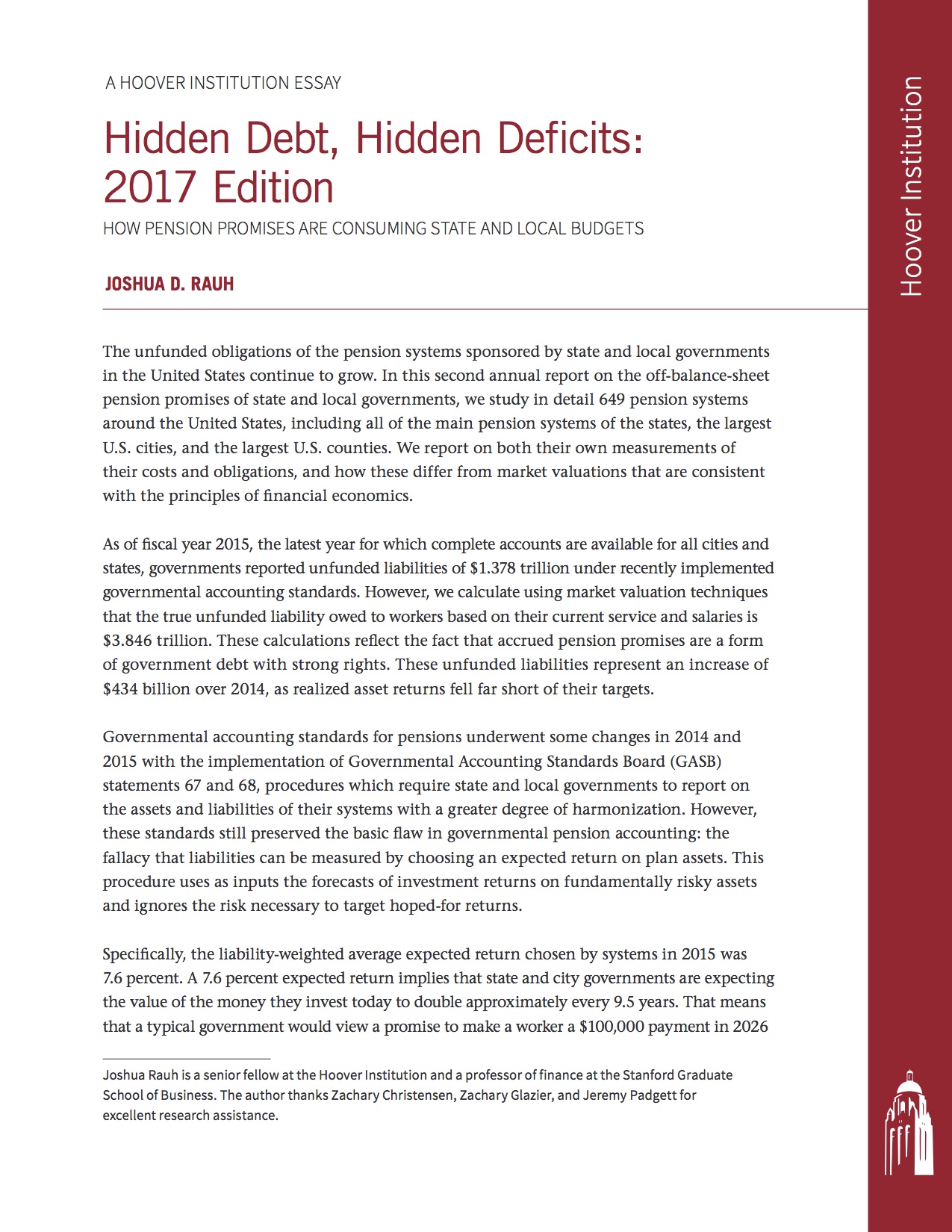With the first publication of Hoover Senior Fellow Joshua Rauh’s essay Hidden Debt, Hidden Deficits two years ago, there was finally a comprehensive look into the burden that state and local government pension promises to public employees are placing on public finances. Now, two years later, Rauh has revisited these fundamentally important questions regarding state and local pensions with a major data update and web resource that highlights the fiscal drag of unfunded pension obligations on state and local government finances.
State and local governments are on the hook to pay retirement benefits to public employees such as teachers and public safety officials. However, governments generally do not set aside enough money to pay for these promises down the road. If the pensions are underfunded, then future taxpayers will have to pay twice for services rendered: once for the salaries of new and current public employees and again for the retirement pensions of the public employees that worked for the city or state in the past. This is increasingly happening now, as pension contributions are among the fastest rising budget items for states and cities.
While state and local governments claim to run balanced budgets, Rauh’s research has shown that in fact they do not. They contribute far less than would be necessary to stabilize the explosive growth of pension promises, relying on flawed measurement standards that understate both the amount of pensions owed to public employees and the costs of maintaining these plans. The result is that citizens are experiencing higher taxes and fees while public services themselves get squeezed.
Rauh’s new figures show that under market valuation principles, the total unfunded pension debt nationwide to public employees rose between 2015 and 2017 from $3.846 trillion to $4.145 trillion. More important, in FY2017, state and local governments contributed $185 billion to pension payments, or 8.0 percent of every dollar they raised in revenue, up dramatically from 4.9 percent in FY2015. However, this amount still proved insufficient, as the true annual cost of keeping pension liabilities from rising would be approximately $338 billion. This “true cost” figure amounts to over 14 percent of all the revenue generated by state and local governments, or a whopping 21 percent of their tax revenue.
When focusing on specific states, these disparities can prove far worse. For example, California state and local governments contributed 12.1 percent of revenues toward servicing its pension liabilities; however, California would have needed to contribute 26.0 percent in order to keep its pension liabilities from rising. For Illinois, these rates are 14.8 percent and 19.8 percent, respectively. Unsurprisingly, the disparities between these states’ stated funding ratios and the market valuation ratios that Rauh calculates are similarly disjointed. In California, based on the government’s own reporting, assets would cover 73.3 percent of promised benefits. However, based on the more appropriate market valuation standards that Rauh calculates, assets would only cover 46 percent of promised benefits. For Illinois, these rates are 45.7 percent and 33.4 percent, respectively.
Some cities are proving to be uniquely problematic, with Chicago, for example, a particularly extreme case. While the city contributed a substantial 33.2 percent of its revenue toward servicing the city’s pensions, the city would have needed to contribute a staggering 66.3 percent of its revenues in order to maintain its existing liability. However, Chicago is not alone. Many other cities face true pension cost burdens that would consume a large portion of municipal financial resources if the cities actually wanted to stop making unfunded promises of pensions to public employees. Such city obligations come on top of their share of any unfunded obligations due to state employees.
As the updated figures illustrate, state and local governments’ own disclosures are still based on discount rates that inappropriately credit state and local governments for unrealistic investment returns. Furthermore, they ignore the financial principles of valuation, which clearly state that both liabilities and costs of pension sponsors should be measured using government bond yields as discount rates. Even with increased contribution rates (from 4.9 percent to 8.0 percent of government revenues, as indicated) and positive market performances in the last two years, the necessary percentage of revenue required to maintain the existing liability has increased from 12.7 to 14.6 percent overall.
Ultimately, more fundamental changes must be made to the funding structures of these pension funds if states want to have any chance at paying down the trillions of dollars of unfunded legacy liabilities. The alternative is higher taxes and diminished services for an increasingly large number of states and cities, and a fiscal crisis that threatens the efficient provision of public services such as education and public safety.
For more information, see:























